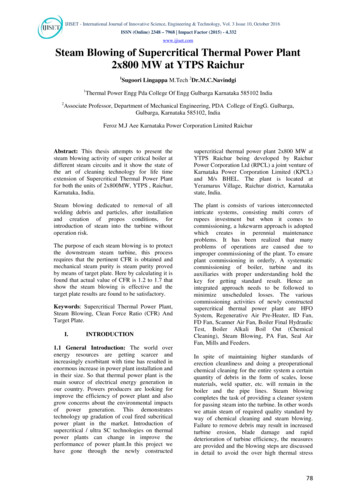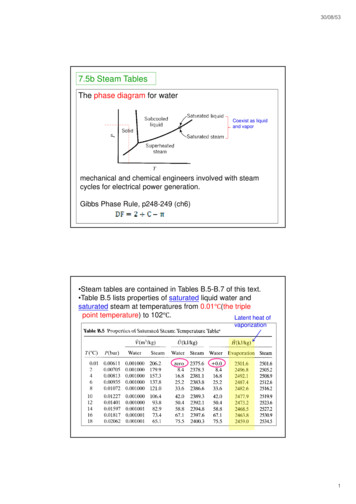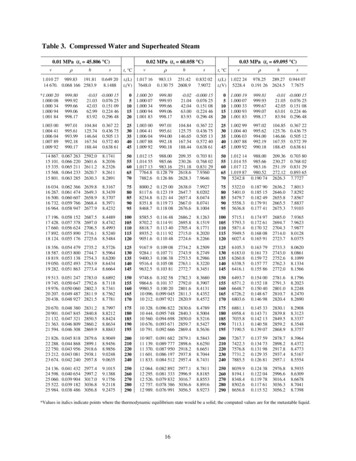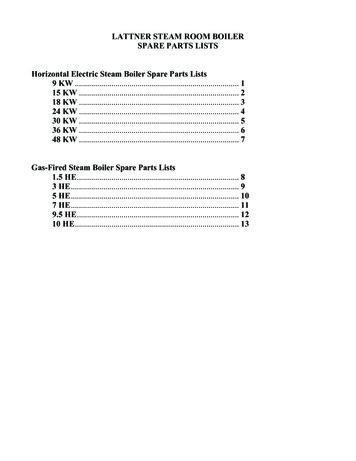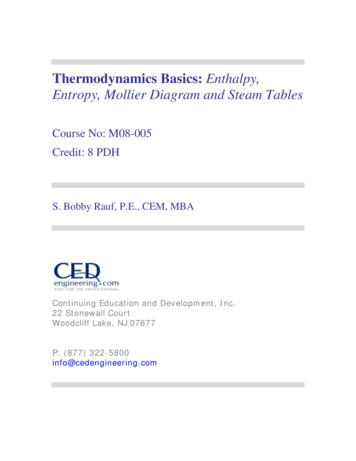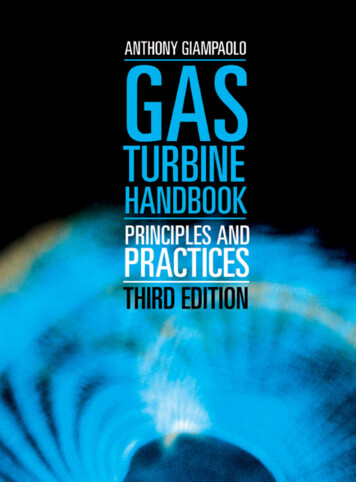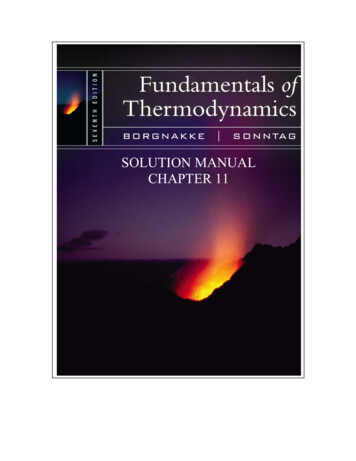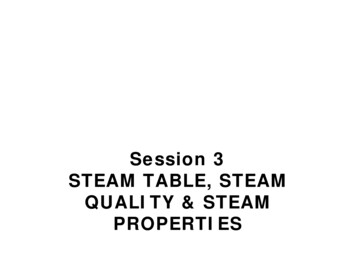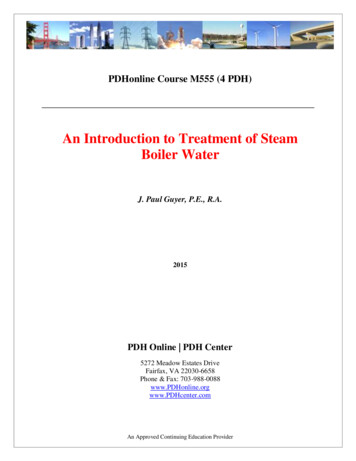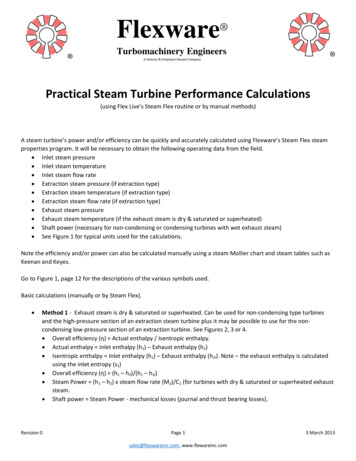
Transcription
Flexware Turbomachinery Engineers A Veteran & Employee Owned CompanyPractical Steam Turbine Performance Calculations(using Flex Live’s Steam Flex routine or by manual methods)A steam turbine’s power and/or efficiency can be quickly and accurately calculated using Flexware’s Steam Flex steamproperties program. It will be necessary to obtain the following operating data from the field. Inlet steam pressure Inlet steam temperature Inlet steam flow rate Extraction steam pressure (if extraction type) Extraction steam temperature (if extraction type) Extraction steam flow rate (if extraction type) Exhaust steam pressure Exhaust steam temperature (if the exhaust steam is dry & saturated or superheated) Shaft power (necessary for non-condensing or condensing turbines with wet exhaust steam) See Figure 1 for typical units used for the calculations.Note the efficiency and/or power can also be calculated manually using a steam Mollier chart and steam tables such asKeenan and Keyes.Go to Figure 1, page 12 for the descriptions of the various symbols used.Basic calculations (manually or by Steam Flex). Method 1 - Exhaust steam is dry & saturated or superheated. Can be used for non-condensing type turbinesand the high-pressure section of an extraction steam turbine plus it may be possible to use for the noncondensing low-pressure section of an extraction turbine. See Figures 2, 3 or 4. Overall efficiency (η) Actual enthalpy / Isentropic enthalpy. Actual enthalpy Inlet enthalpy (h1) – Exhaust enthalpy (h2) Isentropic enthalpy Inlet enthalpy (h1) – Exhaust enthalpy (h2i). Note – the exhaust enthalpy is calculatedusing the inlet entropy (s1) Overall efficiency (η) (h1 – h2)/(h1 – h2i) Steam Power (h1 – h2) x steam flow rate (M2)/C1 (for turbines with dry & saturated or superheated exhauststeam. Shaft power Steam Power - mechanical losses (journal and thrust bearing losses).Revision 0Page 1sales@flexwareinc.com, www.flewareinc.com3 March 2013
Flexware A Veteran & Employee Owned CompanyMethod 2 - Exhaust steam is wet. Can be used for condensing steam turbines and for the low-pressure sectionof extraction steam turbines. See Figure 3 or 4. Shaft Power Known (generator, torque meter coupling or the driven unit’s power) Overall efficiency (η) Actual enthalpy / Isentropic enthalpy Isentropic enthalpy Inlet enthalpy (h1) – Exhaust enthalpy (h2i) - the exhaust enthalpy is calculatedusing the inlet entropy(s1) Steam power Shaft power plus mechanical losses (journal and thrust bearing losses). (h1 – h2) Steam power x C1/Steam flow rate (M2) Overall efficiency (η) (h1 – h2)/(h1 – h2i) Turbomachinery EngineersShaft Power Unknown Do a heat balance on the steam condenser to determine the turbine exhaust enthalpy. See Figure 5 h2 hc (hcw2 – hcw1) x Mcw /M2 If the cooling water flow rate is in volume flow (GPM or m3/hr), convert to mass flow cooling water mass flow (Mcw) cooling water volume flow rate x C2 Overall efficiency (η) (h1 – h2)/(h1 – h2i) Steam power (h1 – h2) x Steam Flow Rate/C1 Shaft power Steam power minus mechanical losses (journal and thrust bearings) Warning – the cooling water temperature rise is very low, so accurate temperature measures are criticalfor reliable results.Special notes for extraction steam turbines High pressure section Use Method 1 for the inlet conditions Use the extraction steam pressure, temperature and enthalpy for the exhaust conditions. Use in the inlet steam flow rate (M1) for the steam flow. Low pressure section Use the extraction steam pressure, temperature and enthalpy for the inlet conditions. The steam flow isthe inlet steam flow rate (M1) minus the extraction steam flow rate Mex). Use Method 1 or Method 2 for the exhaust depending on the exhaust steam conditions.Revision 0Page 2sales@flexwareinc.com, www.flewareinc.com3 March 2013
Flexware Turbomachinery Engineers A Veteran & Employee Owned CompanySteam Turbine Performance ExamplesExample 1 – Non-condensing steam turbine using Steam FlexInput Data:Inlet steam pressureInlet steam temperatureExhaust steam pressureExhaust steam temperatureInlet steam flow rate600 psia700 oF140 psia430 oF75,000 lb/hrResults:Steam PowerOverall efficiency3,339 HP76.6%Notes: Inlet steam flow is used. If the steam leakage for the seals is known, it can be deducted togive a more accurate result. Shaft power can be determined by subtracting the Mechanical Losses (if known) from theSteam Power. See Example 1 Steam Flex below for the summary of resultsRevision 0Page 3sales@flexwareinc.com, www.flewareinc.com3 March 2013
Flexware Turbomachinery EngineersA Veteran & Employee Owned Company Example 1 - Steam Flex Data SummaryRevision 0Page 4sales@flexwareinc.com, www.flewareinc.com3 March 2013
Flexware Turbomachinery Engineers A Veteran & Employee Owned CompanyExample 1 – Non-condensing steam turbine using Mollier method and/or steamtablesInput Data:Inlet steam pressureInlet steam temperatureExhaust steam pressureExhaust steam temperatureInlet steam flow rate600 psia700 oF140 psia430 oF75,000 lb/hrFrom Steam Tables:inlet enthalpy (h1)Inlet entropy (s1)1,351.1 BTU/lb1.5875 BTU/lb oRRead vertically down on Mollier chart to get the isentropic exhaust enthalpyIsentropic exhaust enthalpy (h2i)1202.5 BTU/lb. (Mollier chart)This value can also be obtained from the steam tables by interpolation using the inlet entropyIsentropic exhaust enthalpy (h2i)1203.2 BTU/lb. (steam tables)Actual exhaust enthalpy can be obtained from the steam tablesExhaust enthalpy (h2)1,237.8 BTU/lbEfficiency:Efficiency (η) (h1 – h2)/(h1 – h2i)Efficiency (1,351.1 – 1,202.5)/(1,351.1 – 1,237.8) 76.2% using Mollier chartEfficiency (1,351.1 – 1,203.2)/(1,351.1 – 1,237.8) 76.6% using steam tablesSteam Power:Steam Power (h1 – h2) x steam flow rate (M2)/C1Steam Power (1,351.1 – 1,237.8) x 75,000/2,545 3,339 HPNotes: Inlet steam flow is used. If the steam leakage for the seals is known, it can be deducted togive a more accurate result. Shaft power can be determined by subtracting the Mechanical Losses (if known) from theSteam Power Using the steam tables is generally more accurate than using a Mollier chart.Revision 0Page 5sales@flexwareinc.com, www.flewareinc.com3 March 2013
Flexware Turbomachinery EngineersA Veteran & Employee Owned Company Example 1 - Mollier Chart ResultsRevision 0Page 6sales@flexwareinc.com, www.flewareinc.com3 March 2013
Flexware Turbomachinery Engineers A Veteran & Employee Owned CompanyExample 2 – Condensing steam turbine (Power Known) using Steam FlexInput Data:Inlet steam pressureInlet steam temperatureExhaust steam pressureSteam powerInlet steam flow rate300 psia500 oF4 in Hg a4,600 HP45,000 lb/hrResults:Overall efficiencyExhaust moisture75.0%11.6%Notes: Inlet steam flow is used. If the steam leakage for the seals is known, it can be deducted togive a more accurate result. Shaft power can be determined by subtracting the Mechanical Losses (if known) from theSteam Power. See Example 2 Steam Flex below for the summary of resultsRevision 0Page 7sales@flexwareinc.com, www.flewareinc.com3 March 2013
Flexware Turbomachinery EngineersA Veteran & Employee Owned Company Example 2 - Steam Flex Data Summary (Power Known)Revision 0Page 8sales@flexwareinc.com, www.flewareinc.com3 March 2013
Flexware Turbomachinery Engineers A Veteran & Employee Owned CompanyExample 2 – Condensing steam turbine (Power Known) using Mollier method andsteam tablesInput Data:Inlet steam pressureInlet steam temperatureExhaust steam pressureSteam PowerInlet steam flow rate300 psia500 oF4 in Hg a4,600 HP45,000 lb/hrFrom Steam Tables:Inlet enthalpy (h1)Inlet entropy (s1)1,257.6 BTU/lb1.5701 BTU/lb oRRead vertically down on Mollier chart to get the isentropic exhaust enthalpy. This value cannotbe determined from the steam table because the exhaust is wet.isentropic exhaust enthalpy (h2i)910 BTU/lbExhaust Enthalpy:(h1 – h2) Steam power x C1/Steam flow rate (M2)(h1 – h2) 4,600 x 2,545/45,000 260.2 BTU/lbh2 1,257.6 – 260.2 997.4 BTU/lbEfficiency:Efficiency (η) (h1 – h2)/(h1 – h2i)Efficiency 260.2/(1257.6 – 910) 74.9%Notes: Inlet steam flow is used. If the steam leakage for the seals is known, it can be deducted togive a more accurate result. Shaft power can be determined by subtracting the Mechanical Losses (if known) from theSteam PowerRevision 0Page 9sales@flexwareinc.com, www.flewareinc.com3 March 2013
Flexware Turbomachinery EngineersA Veteran & Employee Owned Company Example 2 - Mollier Chart ResultsRevision 0Page 10sales@flexwareinc.com, www.flewareinc.com3 March 2013
Flexware Turbomachinery Engineers A Veteran & Employee Owned CompanyExample 2 – Condensing steam turbine (Power Unknown) – Steam Flex cannot be usedInput Data:Inlet steam pressureInlet steam temperatureExhaust steam pressureInlet steam flow rateCooling water flow rateCooling water inlet temperatureCooling water discharge temperatureCondensate temperature300 psia500 oF4 in Hg a45,000 lb/hr6,290 GPM85.0 oF98.0 oF123 oFoo(Note, condensate temperature is usually depressed by 2 3 F below saturation (125.4 F) to avoid flashing)Steam Condenser Heat Balance:Liquid enthalpy for condensate (hc)Cooling water inlet enthalpy (hcw1)Cooling water discharge enthalpy (hcw2)90.91 BTU/lb (from steam tables)53.00 BTU/lb (from steam tables)65.97 BTU/lb (from steam tables)Exhaust Enthalpy:h2 hc (h2cw – h1cw) x C2 x Mcw /M2h2 90.91 (65.97 – 53.00) x 500 x 6,290/45,000 997.4 BTU/hrEfficiency:η (h1 – h2)/(h1 – h2i)h2i 910 BTU/lb (from Example 2 Mollier Method above)Efficiency (1,257.6 – 997.4)/(1257.6 – 910) 74.9%Steam Power:Steam power (h1 – h2) x Steam Flow Rate/C1Steam power (1,257.6 – 997.4) x 45,000/2,545 4,601 HPRevision 0Page 11sales@flexwareinc.com, www.flewareinc.com3 March 2013
Flexware Turbomachinery Engineers A Veteran & Employee Owned CompanyFigure 1Inlet pressureP1Typical UnitsEnglish/ImperialTechnical Metricpsiakg/cm2 aExtraction pressurePexpsiakg/cm2 aExhaust pressureP2psiain Hg a (condensing)kg/cm2 amm Hg a (condensing)Inlet steamtemperatureExtraction steamTemperatureExhaust gkW859.85 kcal/kg/kW1,000 kg/m3m3/hkg/hkJ/kgkW3,600 kJ/kg/kW1,000 kg/m3SIbar akPa aMPa abar akPa aMPa abar akPa amm Hg a (condensing)oC(if superheated)Inlet steam flow rateExtraction steam flowrateExhaust steam flow rateCooling watertemperatureCooling water flow rate(Volume)Cooling water flow rate(Mass)Condensate flow rateEnthalpyPowerSteam constantCooling water constantMcond GPMlb/hrhBTU/lbHPC12,545 BTU/hr/HPC2500 lb/hr/GPM(fresh water)Note: All pressures must be in absolute units. If field data is in gauge then add the barometric pressure to thegauge values.Steam Flex can accept temperature units in oF, oR, oC or oK. If the manual system is used, thentemperatures must in oF or oC.Revision 0Page 12sales@flexwareinc.com, www.flewareinc.com3 March 2013
Flexware Turbomachinery EngineersA Veteran & Employee Owned Company Figure 2 – Back Pressure Steam TurbineRevision 0Page 13sales@flexwareinc.com, www.flewareinc.com3 March 2013
Flexware Turbomachinery EngineersA Veteran & Employee Owned Company Figure 3 – Condensing Steam TurbineRevision 0Page 14sales@flexwareinc.com, www.flewareinc.com3 March 2013
Flexware Turbomachinery EngineersA Veteran & Employee Owned Company Figure 4 – Extraction Steam TurbineRevision 0Page 15sales@flexwareinc.com, www.flewareinc.com3 March 2013
Flexware Turbomachinery EngineersA Veteran & Employee Owned Company Figure 5 – Steam CondenserRonald StewartFlexware, IncMarch,2018Revision 0Page 16sales@flexwareinc.com, www.flewareinc.com3 March 2013
Exhaust steam temperature (if the exhaust steam is dry & saturated or superheated) Shaft power (necessary for non-condensing or condensing turbines with wet exhaust steam) . This value can also be obtained from the steam tables by interpolation using the inlet entropy Isentropic exhaust entha
